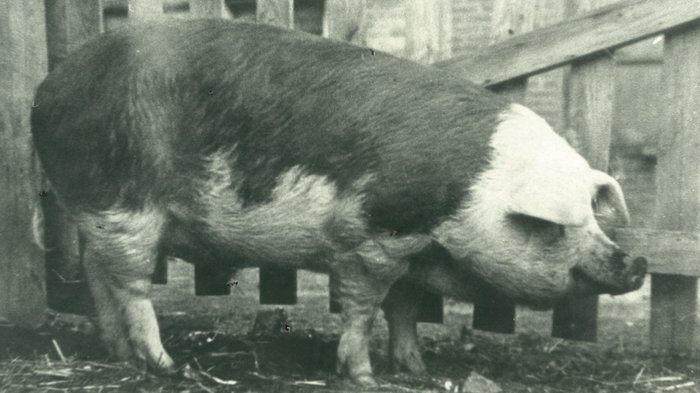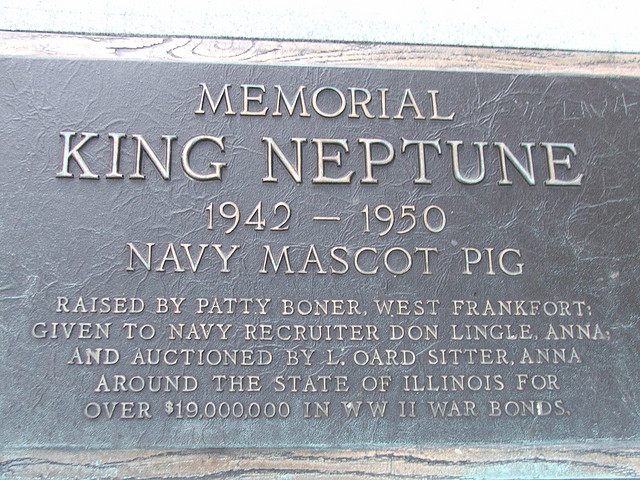The Reign of King Neptune, The Navy’s $250 Million Pig
 (Photo: Union County Historical Museum/Used with Permission)
(Photo: Union County Historical Museum/Used with Permission)
This story was sponsored by the fine folks of Enjoy Illinois.
Every war has its heroes, but some go more unsung than others. Others become king.
One of Illinois’ proudest homefront warriors was just such a royal figure, and he wasn’t even human. King Neptune was actually a fat Hereford swine who managed to raise over $250 million dollars (in modern dollars) for the U.S. Navy by selflessly auctioning off every part of his porcine being for a battleship that never got made.
Born in 1942 on the Boner family farm in West Frankfort, Illinois, the pig who would be king was originally named Parker Neptune, taking the name of his father, Parker Sensation. The runt of 12 piglets born in his litter, Neptune got singled out early when young Patty Boner took a shine to the animal and began to raise him as a project for her local 4-H club. Later that year, her father Sherman, began talking to Marion, Illinois Navy recruiter Don C. Lingle (originally from Anna, Illinois) about pork. Like so many things during World War II, pork was a rationed commodity, but Sherman Boner told Lingle that he could provide him with some pig meat. He was talking about Parker Neptune.
Lingle had intended to use the piglet for a Navy fundraising dinner, upon being presented with the young Neptune, he found that he couldn’t slaughter him, describing the pig in a later interview as “an innocent-looking thing.”
Yet where Lingle saw doe-eyed innocence, he also saw opportunity. If those adorable little piggy eyes could keep this animal from the dinner table, maybe they could open a few charitable wallets as well. Thus, the runty little piglet once known as Parker Neptune, was rechristened King Neptune.
Lingle joined up with local auctioneer, L. Oard Sitter, and took his porky new Navy mascot to a Marion fundraising auction. According to a piece provided by Stu Fliege, Vice-President of the Illinois Historical Society, the war bonds were to help pay for the floundering USS Illinois battleship. On a whim, he draped the pig with a Navy Blue blanket. Maybe it was the blanket, or maybe it was the look in his eyes, but bits of Neptune began flying off the stage. As told in an article in the Southeastern Missourian, people were pledging $100 in war bonds for a leg! $300 for a shoulder! By the end of his first appearance, King Neptune had raised $11,200.
After the massive success of his first appearance, by his next, he was given a little crown that was strapped on top of the blanket with an elastic band, and he was adorned with silver earrings and painted hooves. By his third appearance, King Neptune was drawing around $50,000 in bonds. Lingle and Sitter began parading him around fundraising events all across southern Illinois. At each auction, parts of the growing pig would be sold off to the highest bidder, who could have demanded their pound or so of flesh, but no one ever did, and Lingle was able to keep King Neptune each time. As the pig’s fame grew, larger fundraising auctions across the state began demanding an appearance from the Navy’s increasingly rotund mascot.
King Neptune began to be known as the “red, white, and blue pig,” for his red and white coloration, and the blue of his eyes (or possibly his blanket). In 1943, then Illinois governor Dwight H. Green straight up bought King Neptune for a million dollars. Of course, he too returned the porker. Many of Neptune’s appearances were sponsored by local chapters of the Elks, and the famous pig eventually even became an honorary member of a number of chapters of the fraternal organization.
By the time the war ended, Lingle and King Neptune had raised over $19 million for the Navy, which in today’s dollars would read more like $250 million. Unfortunately despite raising more money than possibly any other single pig in the history of the world, it still was not enough to fund the creation of the USS Illinois, which was cancelled in 1945 after 22 percent of the ship had been completed. Nonetheless, King Neptune still raked it in for the Navy.
 (Photo: Eric Crowley/Flickr)
(Photo: Eric Crowley/Flickr)
With his fundraising life seemingly at an end, the Navy moved to have King Neptune sent to the Chicago Stockyards in 1946, but Lingle swept in once again before the King was made into bacon. Lingle sent the pig to live on the farm of Ernest Goddard, who continued to load the pig into his truck and parade him around.
By the time King Neptune made it to the Goddard farm, his celebrity lifestyle had seen him plump up to around 500 pounds, and he continued to grow until he weighed a whopping 700 pounds, and was so fat that his hanging eye folds had essentially blinded him. According to an NPR interview with Goddard’s grandson Jim, they had to lead King Neptune around by tapping his head with a stick.
King Neptune finally died in 1950, a couple days short of 8 years old. For his services, King Neptune was given a Navy funeral with full military honors, and buried just outside of Anna under a headstone noting the pig’s efforts “to help make a free world.”
Unfortunately not long after he was buried the creation of a new highway saw his grave moved to a new site where vandalism and neglect soon took over. In response to the damage being caused to King Neptune’s headstone, a brass memorial plaque was installed outside of the Trail of Tears Tourist Information Center located at a rest stop off of I-57.
Speaking both with members of the Illinois Historical Society and members of the Union County Clerk’s office, it seems that older generations are well aware of King Neptune and his heroic legacy, but it be being forgotten by many younger people. But we should all salute, the hero, the pig, the King. God Oink the U.S.A.!






Follow us on Twitter to get the latest on the world's hidden wonders.
Like us on Facebook to get the latest on the world's hidden wonders.
Follow us on Twitter Like us on Facebook